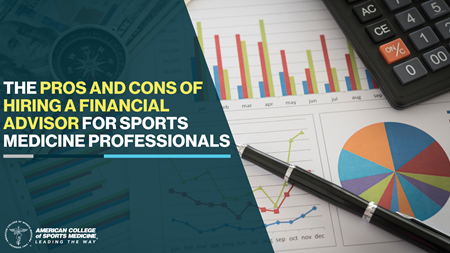by
Greg Margason
| Jul 24, 2023

Are you tired of feeling overwhelmed and stressed when it comes to your finances? You’re not alone. As a sports medicine professional, you’re no stranger to the ups and downs of the industry. Frequent injuries and hectic schedules can make your job incredibly demanding. Even stressful. But there’s one thing that shouldn’t keep you up at night: your finances. And that’s where a financial advisor comes in.
I know. The idea of handing your money to someone else can be intimidating, anxiety-inducing, scary, the last thing you ever want to do in your entire life... just fill in the blank. And with so many options out there, it can be tough to know whether it’s worth the investment.
You might even be thinking, “Why pay for something I can do myself?” Before you roll your eyes and dismiss the idea of hiring a financial advisor, let me ask you this: Do you really have the time and expertise to handle your finances on your own? When it comes to managing your money, the stakes are high. One mistake could set you back years. So let’s weigh the pros and cons of hiring a financial advisor and see if it’s worth the investment.
The Pros of Hiring a Financial Advisor
Experience and Knowledge
One of the biggest advantages of hiring a financial advisor is their experience and knowledge of the financial industry. They have a deep understanding of the financial products and services available as well as in-depth knowledge of tax-saving and investment strategies. With their guidance, you can make informed decisions that align with your financial goals.
Time-Saving Benefits
Another benefit of hiring a financial advisor is the time-saving benefits. They can free up your time to focus on your work and personal life while also providing comprehensive financial planning and management services. Additionally, if you're dealing with complex financial situations, they can handle them on your behalf and provide guidance on the best course of action.
Improved Investment Performance
Financial advisors can also help improve your investment performance. By developing personalized investment strategies based on your individual goals and risk tolerance, they can help you with potential returns. They also have access to professional research and analysis, and can actively manage your investment portfolio to maximize your potential returns.
The Cons of Hiring a Financial Advisor
Costs and Fees
One of the biggest drawbacks of hiring a financial advisor is the costs and fees associated with their services. These can come in the form of commission-based fees or asset-based fees, and there is also a potential for conflicts of interest and hidden or undisclosed fees. It’s important to thoroughly research and understand the fees before hiring an advisor.
Lack of Control and Autonomy
Another potential drawback of hiring a financial advisor is the lack of control and autonomy over your financial decisions. By handing over control to another person, you may feel like you’ve lost agency over your own finances. Additionally, it can be difficult to find an advisor who aligns with your personal values and goals, which can cause friction in the relationship.
Making the Right Decision for You: Weighing the Pros and Cons
Now that you know the pros and cons of hiring a financial advisor, let’s take a moment to reflect on your financial journey so far. Have you been living the high life like a pro athlete with a fat bank account, or are you still waiting for your big break? Either way, it’s never too early or too late to start planning for your financial future.
As a sports medicine professional, you’re used to taking care of your physical health, but what about your financial health? Working with a financial advisor can help you create a game plan that works for you and your unique financial situation.
So what’s next? If you’re ready to take the next step and work with a financial advisor, take the time to do your research, ask questions, and find an advisor who aligns with your values and goals. Together, you can work toward achieving financial security and setting yourself up for long-term success.
If you’re interested in learning more about how a financial advisor can benefit your unique situation, don’t hesitate to reach out and schedule a meeting.
Related content:
Blog | Traditional vs. Roth IRA: Which Is Better for Sports Medicine Professionals?

Jason Korzan is based in Atlanta, GA and runs a financial advisory practice associated with Consolidated Planning. Having dedicated a significant portion of his professional life to assisting multimillion dollar manufacturing companies in financial management, he decided to turn his attention to his genuine passion: helping families organize, protect, and focus their financial resources. As a former collegiate baseball player, coach, and lifelong athlete, Jason focuses his practice on delivering tailored financial solutions to sports medicine professionals, helping them achieve financial fitness alongside their physical endeavors.
Registered Representative and Financial Advisor of Park Avenue Securities LLC (PAS). OSJ: 6115 PARK SOUTH DRIVE, SUITE 200, CHARLOTTE NC, 28210, 704-5528507. Securities products and advisory services offered through PAS, member FINRA, SIPC. Financial Representative of The Guardian Life Insurance Company of America® (Guardian), New York, NY. PAS is a wholly owned subsidiary of Guardian. Consolidated Planning, Inc. is not an affiliate or subsidiary of PAS or Guardian. 2023-156982 Exp. 6/25